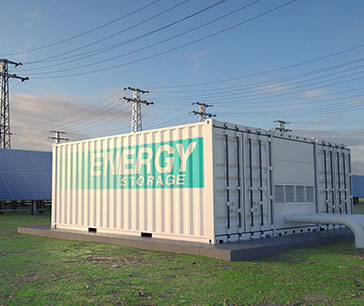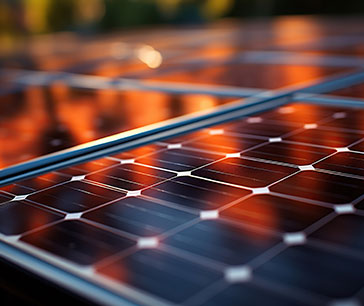Table Of Contents
- Renewable Energy: A Beacon of Hope
- Internet of Energy (IoE): Upgrading the Traditional Electric Power Systems
- Energy Storage: Reshaping the Power Industry
- Energy as a Service (EaaS): Transitioning to Service-Oriented Models
- Distributed Energy Resources (DERs): Transforming Electricity Generation and Consumption
- AMR’s Verdict

Yerukola Eswara Prasad

Pooja Parvatkar
Energy & Power Sector Trends: Here’s What Q1 2024 Reveals About the Evolving Industry

The year 2022 marked a period of profound challenges for the global energy landscape, characterized by an unprecedented energy crisis and mixed results from the COP27 summit. With the world dealing with the consequences, 2023 has been a critical year for the energy & power sector, signaling the need for a more rapid and favorable change in the energy sector. Allied Market Research has taken an initiative to highlight several key trends that shaped the industry in Q1 2024. From renewable energy to the Internet of Energy (IoE), energy storage, Energy as a Service (EaaS), and Distributed Energy Resources (DERs), the sector is witnessing transformative changes.
Renewable Energy: A Beacon of Hope
The renewable energy sector is poised for a variable-speed takeoff, driven by historic investments, growing competitiveness, and increasing demand. The environmental benefits of renewable energy sources, which produce minimal to zero harmful emissions, make them a crucial component in the fight against climate change. The adoption of renewable energy sources is not just a technological shift but also a response to the rise in consumer awareness and demand for sustainable living practices.
Governments worldwide are focusing on promoting renewable energy sources due to their increased output efficiency, lower pollution, and reduced maintenance costs. The global renewable energy market is projected to reach $1,977.6 billion by 2030, growing at a CAGR of 8.4% from 2021 to 2030. As nations strive to combat climate change, the role of renewable energy in reducing the global carbon footprint is set to become increasingly significant in 2024.
Internet of Energy (IoE): Upgrading the Traditional Electric Power Systems
The Internet of Energy (IoE) is reshaping traditional electric power systems, introducing a smart energy infrastructure that utilizes the Internet of Things (IoT) to connect every point within the power grid. This includes generation, load, distribution, storage, and smart meters. By incorporating IoT technologies, the IoE enhances the efficiency, resiliency, and reliability of the power grid. Real-time consumption monitoring facilitates better regulation of production and distribution, contributing to reduced CO2 emissions and more efficient energy production.
IoE technologies provide major solutions to extend the lifespan of assets in both production and transmission. Predictive maintenance becomes possible through the data collected by smart meters and sensors, enabling engineers to anticipate and address potential anomalies in the system. The IoE is a critical component in achieving a more sustainable and resilient energy ecosystem.
Energy Storage: Reshaping the Power Industry
Dynamic trends in energy storage are reshaping the energy & power industry, addressing the challenge of insufficient cost-effective energy storage solutions. Energy storage not only enables stable pricing by proactively managing consumer demand but also allows consumers to stock up on energy during ideal conditions. This accumulated energy helps reduce grid loads during peak times, benefiting both consumers and prosumers.

Strategic deals and innovative patents are driving advancements in energy storage technologies. The global solar energy storage market is projected to reach $20.9 billion by 2031, growing at a CAGR of 7.9% from 2022 to 2031. However, challenges persist in some regions. For instance, in India, the grid-scale solar installation market has faced a 20% decline, impacting the growth rate of the solar energy storage market. Yet, supportive government policies and initiatives are expected to fuel a resurgence in solar energy storage sales, particularly as various sectors recover post the COVID-19 period.
Energy as a Service (EaaS): Transitioning to Service-Oriented Models
Energy as a Service (EaaS) is ushering in a transition from selling electricity to providing services such as consumption management, production optimization, and consumption tracking. This model accelerates energy efficiency across the grid, making it accessible to a broader audience. The absence of upfront capital investment costs is a key driver for the adoption of EaaS.
The global energy as a service market is projected to reach $112.7 billion by 2030, growing at a CAGR of 7.6% from 2021 to 2030. Building owners are increasingly focusing on reducing energy costs, adopting renewable energy, and installing distributed generation sources, contributing to the growth of this swiftly evolving model.
Distributed Energy Resources (DERs): Transforming Electricity Generation and Consumption
Distributed Energy Resources (DERs) represent small-scale energy resources located near electricity consumption sites, such as rooftop solar panels and battery storage. They enable consumers to produce and share surplus energy within a network, emphasizing sustainability and eco-friendliness. The rising trend of DERs adoption is reshaping electricity generation, distribution, and consumption dynamics, eliminating energy transmission losses and costs.

The DERs market is witnessing a surge in environmentally sustainable and technologically advanced products. State-of-the-art technologies, including artificial intelligence, machine learning, and blockchain, are being integrated to enhance product quality and efficiency. This reflects a broader trend in the industry towards innovation and sustainability.
AMR’s Verdict
In the rapidly evolving landscape of the energy and power industry, the trends highlighted in Q1 2024 are indicative of a transformative era. From the remarkable ascent of renewable energy as a beacon of hope to the revolutionary impact of the Internet of Energy (IoE) on traditional power systems, and the pivotal role of energy storage, Energy as a Service (EaaS), and Distributed Energy Resources (DERs), the sector is undergoing a profound metamorphosis. AMR analysts foresee these trends as not just transient shifts but as harbingers of a sustainable, resilient, and efficient energy future. For a more in-depth analysis and strategic insights tailored to your organization, contact AMR analysts today.

